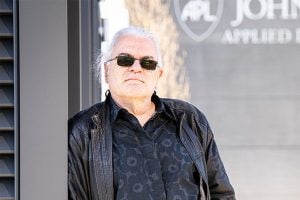
Robert Osiander, an instructor in the Engineering for Professionals programs in Materials Science and Engineering, and Space Systems Engineering was honored by JHU’s Applied Physics Laboratory as a Master Inventor, recognizing his role as the test lead working on the sensors that will gauge the wind speed, pressure and temperature of the atmosphere of Saturn’s largest moon, Titan.
Osiander’s 10 patents address a range of challenges and gaps — including biomedical innovations, novel materials and navigation tools.
Osiander teaches Nanomaterials – 515.617 and Advanced Topics in Aerospace Hardware – 675.732.
Currently, he’s channeling his curiosity and creativity as test lead for the Dragonfly Geophysics and Meteorology (or “DraGMet”) sensors, which will gauge the wind speed, pressure and temperature of the atmosphere of Saturn’s largest moon, Titan. The sensors will fly aboard NASA’s Dragonfly rotorcraft-lander, which is scheduled to launch in 2028.
“Dragonfly is the most spectacular and most challenging mission I’ve ever had the honor to work on,” said Osiander. “I enjoy coming to work to tackle the tough challenges with our team and contribute to this innovative spacecraft.”
Throughout his APL tenure, Osiander has regularly tapped into the Laboratory’s comprehensive innovation initiatives to move his ideas from concept to reality.
Innovation is central to APL’s mission, driving the development of cutting-edge solutions to complex national security and scientific challenges. APL specifically dedicates a significant portion of its total internal funding to its Innovation and Collaboration program, which inspires, engages and empowers staff members to explore new ideas and bring ingenuity into all that they do. One of the program’s initiatives, Project Catalyst, consists of three grant types (Ignition, Combustion and Propulsion) to fund bold, high-risk and transformational ideas that have the potential to solve the nation’s greatest challenges.
Osiander was awarded prizes linking back to those grants twice, including the Ignition Grant prize for innovation in 2013 and the Propulsion Grant prize for innovation in 2020.
In partnership with fellow APL staff member Ann Darrin, Osiander secured funding in 2013 to launch a maker space named “Central Spark” at the Laboratory. Now, more than a decade later, Central Spark is not only thriving but has become a hub for creativity and hands-on innovation.
“Robert is always ready to explore new ideas and solutions,” said Darrin, an aerospace engineer and longtime colleague of Osiander. “His willingness to engage in any ‘what-if’ scenarios and his unwavering support for his peers highlight his legacy as both an innovator and a mentor.”
Because of the ingenuity and commitment of staff members like Osiander and the impact those ideas can have, APL is consistently named among the top innovative workplaces in the world.
Article content from Johns Hopkins Applied Physics Laboratory website.